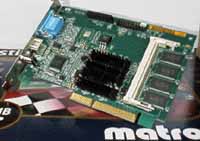| Work and play, according to virtually all video card manufacturers, can't coexist. There will always be the leading gaming solution, and the leading business solution, never a product tailored to perform equally well in both arenas. While one may argue that it is a simple marketing tactic to boost sales, the bottom line is that there is a product suited for every need you may have. But when does a product, or in this case, a video card, leave the segregated work/play theory behind and truly become a one size fits all solution? |  |
| This is the topic that has been surrounding two particular video accelerators, both from Matrox Graphics, and both based on the same G200 chipset, what makes them different? Unfortunately there is very little that sets the two apart aside from what the naked eye can perceive. | |
Originally thought to be the best 2D solution for any home/desktop system, the Matrox Millennium which was later succeeded by the Millennium II, brought a certain level of quality and performance to the market that was left unparalleled by any other manufacturer for quite some time. Carrying on the tradition of the Millennium name, when Matrox announced the release of their G200 graphics chipset, they released two products. One geared towards the home user market, the Mystique G200, and one more fit for the Business market, rightfully entitled the Millennium G200.
In the past that which separated the Millennium from the Mystique series of graphics accelerators was sheer performance in addition to differences in hardware specifications and software bundles. The reason for this was usually courtesy of a three fold solution: 1) differences brought on by the use of two different Matrox chipsets, 2) differences brought on by the use of a different speed RAMDAC, and 3) differences brought on by the use of different types of video memory. This time around, instead of carrying on tradition with that three fold solution to making a Millennium differ from a Mystique, Matrox chose to simply outfit the Millennium G200 with a faster RAMDAC (the component which directly determines the refresh rate and eventually, the 2D image quality) and faster, yet more expensive video memory.
Here's where things get a bit complicated, at the heart of both the Millennium G200 and Mystique G200 is the same graphics chipset, the Matrox G200. There is absolutely no difference between the two cards on the lowest of levels, including minimum performance. The Mystique branches off into the home market by adding support for TV-Output, while compensating for the cost of the addition of a TV-Out feature by using a 230MHz RAMDAC and SDRAM for the video memory. Like a teenager looking to stand out at a party, the Millennium G200 separates itself by dressing out with a 250MHz RAMDAC (as opposed to the 230MHz RAMDAC on the Mystique) and picking up a set of high speed SGRAM to replace the slower SDRAM present on the Mystique's design. The cost of these two additions does come at a premium price to the user. In order to gain the extra performance and image quality provided for by the SGRAM and the 250MHz RAMDAC while maintaining an equal price level between both cards as to not unevenly balance sales, the Millennium G200 loses the high quality TV-Output feature that the Mystique G200 boasts.
Now before you approach any quick decisions, a few items must be cleared up. First of all, will you notice the difference between the 250MHz RAMDAC on the Millennium and the 230MHz RAMDAC on the Mystique? That depends on the size of your monitor, and the resolution/refresh rate you plan on running it at. As long as you don't plan on using resolutions higher than 1280 x 1024, the difference in image quality (2D) between the Millennium and the Mystique G200 boards is marginal. If you plan on running at resolutions higher than that, such as 1600 x 1200, then you may want to opt for the Millennium over the Mystique. In which case you won't have to worry about the loss of a TV-Output port since the quality of a monitor capable of legibly running at 1600 x 1200 is much better than that of a standard TV. Which brings us to the second point, that in spite of the quality of the TV-Output on the Mystique G200, the quality of an image displayed on a NTSC or PAL TV is incredibly poor in comparison to a good computer monitor simply because of the attainable resolutions on a monitor vs those on a TV. For anyone with a 17" or greater sized monitor, the TV-Output feature will probably be more of a useless tool than a unique feature. If you happen to be limited to a 14" or 15" display, then the Mystique G200 will become a more appetizing solution because of its TV-Output.










0 Comments
View All Comments